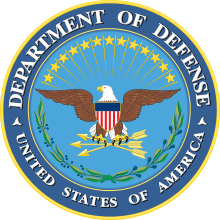Joint Chiefs of Staff
| Joint Chiefs of Staff | |
|---|---|
| JCS | |
|
| |
| Role | Advisory board providing professional military advice to the Secretary of Defense and the President |
| Established in practice | 1942 |
| Constituting instrument |
National Security Act of 1947 currently codified at 10 U.S.C. § 151 |
| Predecessor entities |
Joint Board (1903–1942) |
| Members | |
| Chairman | Joseph Dunford |
| Vice Chairman | Paul J. Selva |
| Number of members | Seven |
| Administration | |
| Parent agency | U.S. Department of Defense |
| Staff organization | The Joint Staff (For the Chairman and the Vice Chairman; the service chiefs and the NGB chief have their own staffs assisting them) |
| Seat | The Pentagon |
The Joint Chiefs of Staff (JCS) is a body of senior uniformed leaders in the United States Department of Defense who advise the President of the United States, the Secretary of Defense, the Homeland Security Council and the National Security Council on military matters. The composition of the Joint Chiefs of Staff is defined by statute and consists of the Chairman of the Joint Chiefs of Staff (CJCS), Vice Chairman of the Joint Chiefs of Staff (VCJCS), and the Military Service Chiefs from the Army, Marine Corps, Navy, Air Force, and the Chief of the National Guard Bureau,[1] all appointed by the President following Senate confirmation.[2] Each of the individual Military Service Chiefs, outside of their Joint Chiefs of Staff obligations, works directly for the Secretary of the Military Department concerned, i.e., Secretary of the Army, Secretary of the Navy, and the Secretary of the Air Force.[3][4][5][6]
Following the Goldwater–Nichols Act in 1986, the Joint Chiefs of Staff do not have operational command authority, neither individually nor collectively, as the chain of command goes from the President to the Secretary of Defense, and from the Secretary of Defense to the Commanders of the Combatant Commands.[7] Goldwater–Nichols also created the office of Vice Chairman, and the Chairman is now designated as the principal military adviser to the Secretary of Defense, the Homeland Security Council, the National Security Council and the President.[8]
The Joint Staff (JS) is a headquarters staff in the Pentagon, composed of personnel from each of the four Department of Defense armed services, that assists the Chairman and the Vice Chairman in discharging their responsibilities and is managed by the Director of the Joint Staff (DJS), who is a lieutenant general or Navy vice admiral.[9]
Role and responsibilities
.jpg)
After the 1986 reorganization of the military undertaken by the Goldwater-Nichols Act, the Joint Chiefs of Staff does not have operational command of U.S. military forces. Responsibility for conducting military operations goes from the President to the Secretary of Defense directly to the commanders of the Unified Combatant Commands and thus bypasses the Joint Chiefs of Staff completely.
Today, their primary responsibility is to ensure the personnel readiness, policy, planning and training of their respective military services for the combatant commanders to utilize. The Joint Chiefs of Staff also act in a military advisory capacity for the President of the United States and the Secretary of Defense. In addition, the Chairman of the Joint Chiefs of Staff acts as the chief military advisor to the President and the Secretary of Defense. In this strictly advisory role, the Joint Chiefs constitute the second-highest deliberatory body for military policy, after the National Security Council and the Homeland Security Council, which includes the President and other officials besides the Chairman of the Joint Chiefs.
While serving as chairman or Vice Chairman of the Joint Chiefs of Staff, Chief of Staff of the Army, Commandant of the Marine Corps, Chief of Naval Operations, Chief of Staff of the Air Force, or Commandant of the Coast Guard, the salary is $20,263.50 a month,[10] regardless of cumulative years of service completed under section 205 of title 37, United States Code.
Current members of the Joint Chiefs of Staff
Notes:
- The Joint Chiefs do not include the Commandant of the Coast Guard because the Coast Guard is normally under the Department of Homeland Security, where the other four branches are under the Department of Defense. However, the Coast Guard is always a military service (14 United States Code, section 1) and may operate under the Department of the Navy during wartime. The commandant of the Coast Guard is however, occasionally invited by the chairman to attend meetings of the Joint Chiefs of Staff.[11]
History
Joint Board
As the military of the United States grew in size following the American Civil War, joint military action between the U.S. Army and U.S. Navy became increasingly difficult. The Army and Navy were unsupportive of each other at either the planning or operational level and were constrained by disagreements during the Spanish–American War in the Caribbean campaigns.[12] The Joint Army and Navy Board was established in 1903 by President Theodore Roosevelt, comprising representatives from the military heads and chief planners of both the Navy's General Board and the Army's General Staff. The Joint Board acting as an "advisory committee" was created to plan joint operations and resolve problems of common rivalry between the two services.[12]
Yet, the Joint Board accomplished little as its charter gave it no authority to enforce its decisions. The Joint Board also lacked the ability to originate its own opinions and was thus limited to commenting only on the problems submitted to it by the Secretaries of War and Navy. As a result, the Joint Board had little to no impact on the manner the United States conducted World War I.
After World War I, in 1919 the two Secretaries agreed to reestablish and revitalize the Joint Board. The mission of the General staff was to develop plans for mobilization for the next war; the US was always designated "Blue" and potential enemies were assigned various other colors.[13]
This time, the Joint Board's membership would include the Chiefs of Staff, their deputies, and the Chief of War Plans Division for the Army and Director of Plans Division for the Navy. Under the Joint Board would be a staff called the Joint Planning Committee to serve the Board. Along with new membership, the Joint Board could initiate recommendations on its own initiative. However, the Joint Board still did not possess the legal authority to enforce its decisions.
World War II
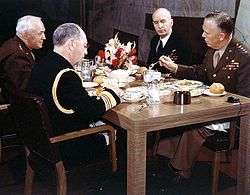
President of the United States Franklin D. Roosevelt and Prime Minister of the United Kingdom Winston Churchill established the Combined Chiefs of Staff (CCS) during the 1942 Arcadia Conference.[14] The CCS would serve as the supreme military body for strategic direction of the combined US-British Empire war effort.
The UK portion of the CCS would be composed of the British Chiefs of Staff Committee, but the United States had no equivalent body. The Joint Board's lack of authority made it of little use to the CCS, although its 1935 publication, Joint Action of the Army and Navy, did give some guidance for the joint operations during World War II. The Joint Board had little influence during the war and was ultimately disbanded in 1947.
As a counterpart to the UK's Chiefs of Staff Committee in the CCS, and to provide better coordinated effort and coordinated staff work for America's military effort, Admiral William D. Leahy proposed a "unified high command" in what would come to be called the Joint Chiefs of Staff. Modeled on the British Chiefs of Staff Committee, the JCS' first formal meeting was held on 9 February 1942, to coordinate U.S. military operations between War and Navy Departments.[14][15] The official history of the Army Air Forces noted that although there was "no official charter establishing this committee...by the end of February it had assumed responsibilities toward the American war effort comparable to the CCS on the combined level."[16] On 20 July 1942, Admiral Leahy became the Chief of Staff to the Commander in Chief of the Army and Navy ("Commander in Chief of the Army and Navy of the United States" is the military title of the U.S. President, per Article II, § 2, of the Constitution), with the chiefs of staff of the services serving under his leadership.
The first members of the Joint Chiefs of Staff were:[17]
| Name | Service | Position |
|---|---|---|
| Admiral William D. Leahy | USN | Chief of Staff to the Commander in Chief of the Army and Navy and Special Presidential Military Advisor |
| General George C. Marshall | USA | Chief of Staff of the United States Army (CSUSA) |
| Admiral Ernest J. King | USN | Commander in Chief of the United States Fleet and Chief of Naval Operations (COMINCH-CNO) |
| General Hap H. Arnold | USA | Chief of the Army Air Forces and Deputy Chief of Staff for Air |
As the table indicates, each of the members of the original Joint Chiefs was a four-star flag officer in his respective service branch. By the end of the war, however, each had been promoted: Leahy and King to Fleet Admiral; Marshall and Arnold to General of the Army. Arnold was later appointed to the grade of General of the Air Force.
One of the Joint Chiefs of Staff's committees was the Joint Strategic Survey Committee (JSSC). The JSSC was an extraordinary JCS committee that existed from 1942 until 1947. It was "one of the most influential planning agencies in the wartime armed forces."[18] Members included Lieutenant General Stanley D. Embick, U.S. Army, chairman, 1942–, Vice Admiral Russell Willson, U.S. Navy, 1942–1945, Vice Admiral Theodore Stark Wilkinson, U.S. Navy, 1946, and Major General Muir S. Fairchild, U.S. Army Air Force, 1942–.
National Security Act of 1947
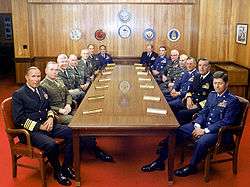
With the end of World War II, the Joint Chiefs of Staff was officially established under the National Security Act of 1947. Per the National Security Act, the JCS consisted of a chairman, the Chief of Staff of the Army, the Chief of Staff of the Air Force (which was established as a separate service by the same Act), and the Chief of Naval Operations. The Commandant of the Marine Corps was to be consulted on matters concerning the Corps, but was not a regular member; General Lemuel C. Shepherd, Jr., Commandant in 1952–55, was the first to sit as an occasional member. The law was amended during the term of General Louis H. Wilson, Jr. (1975–79), making the Commandant a full-time JCS member in parity with the other three DoD services.
The position of vice-chairman was created by the Goldwater–Nichols Act of 1986 to complement the CJCS, as well as to delegate some of the chairman's responsibilities, particularly resource allocation through the Joint Requirements Oversight Council (JROC).
General Colin L. Powell (1989–93) was the first and, as of 2011, the only African American to serve on the Joint Chiefs of Staff. General Peter Pace (Vice chairman 2001–05; Chairman, 2005–07) was the first Marine to serve in either position. No woman has ever served on the Joint Chiefs of Staff.
National Defense Authorization Act of 2012
A provision in the 2012 National Defense Authorization Act added the Chief of the National Guard Bureau to the Joint Chiefs of Staff. Guard historians called it the "most significant development" for the National Guard since the Militia Act of 1903.[1]
Organization and leadership positions
Chairman
The Chairman of the Joint Chiefs of Staff is, by law, the highest-ranking military officer of the United States Armed Forces,[19] and the principal military adviser to the President of the United States. He leads the meetings and coordinates the efforts of the Joint Chiefs of Staff, comprising the chairman, the Vice Chairman of the Joint Chiefs of Staff, the Chief of Staff of the United States Army, the Commandant of the United States Marine Corps, the Chief of Naval Operations, the Chief of Staff of the United States Air Force, and the Chief of the National Guard Bureau. The Joint Chiefs of Staff have offices in The Pentagon. The chairman outranks all respective heads of each service branch,[20] but does not have command authority over them, their service branches or the Unified Combatant Commands.[20] All combatant commanders receive operational orders directly from the Secretary of Defense.[21]
The current chairman is General Joseph Dunford, USMC, who began his term on October 1, 2015.
On 20 July 1942, Navy Fleet Admiral William D. Leahy became the Chief of Staff to the Commander in Chief of the Army and Navy (20 July 1942 – 21 March 1949). He was not technically the Chairman of the Joint Chiefs of Staff. Leahy's office was the precursor to the post of Chairman of the Joint Chiefs of Staff. That post was established and first held by General of the Army Omar Bradley in 1949.
Vice Chairman
The position of Vice Chairman of the Joint Chiefs of Staff was created by the Goldwater-Nichols Act of 1986. The vice-chairman is a four-star-general or admiral and, by law, is the second highest-ranking member of the U.S. Armed Forces (after the Chairman of the Joint Chiefs of Staff). In the absence of the chairman, the vice-chairman presides over the meetings of the Joint Chiefs of Staff. He may also perform such duties as the chairman may prescribe. It was not until the National Defense Authorization Act in 1992 that the position was made a full voting member of the JCS.[22]
The current vice-chairman is General Paul J. Selva, USAF.
Senior Enlisted Advisor to the Chairman
The Senior Enlisted Advisor to the Chairman of the Joint Chiefs of Staff (SEAC) advises on all matters concerning joint and combined total force integration, utilization, development, and helps develop noncommissioned officers related joint professional education, enhance utilization of senior NCOs on joint battle staffs, and support the chairman’s responsibilities as directed.
Command Sergeant Major William Gainey, USA, was the first SEAC, serving from October 1, 2005. The current SEAC is Command Sergeant Major John W. Troxell, U.S.A., who was sworn in by Joint Chiefs Chairman General Joseph Dunford on December 11, 2015, replacing Sergeant Major Bryan B. Battaglia, USMC.
The Joint Staff
|
| |
| Agency overview | |
|---|---|
| Formed | 1949 |
| Headquarters | The Pentagon |
| Employees | Approx. 1,500 |
| Agency executive |
|
| Parent agency | Department of Defense |

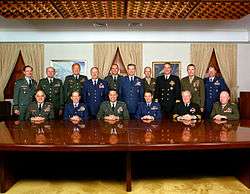
The Joint Staff (JS) is a military headquarters staff based at the Pentagon, composed of personnel from all the four DoD services, assisting the Chairman and the Vice Chairman in discharging their responsibilities. They work closely with the Office of the Secretary of Defense (OSD), the Military Department staffs, and the Combatant Command Staffs.
The Chairman of the Joint Chiefs of Staff is assisted by the Director of the Joint Staff, a three-star officer who assists the chairman with the management of the Joint Staff, an organization composed of approximately equal numbers of officers contributed by the Army, the Navy and Marine Corps, and the Air Force, who have been assigned to assist the chairman in providing to the Secretary of Defense unified strategic direction, operation, and integration of the combatant land, naval, and air forces.
Directorates of the Joint Staff
The Joint Staff includes the following departments where all the planning, policies, intelligence, manpower, communications and logistics functions are translated into action.[23]
- Joint Staff Information Management Division (United States)
- DOM – Directorate of Management
- J1 – Personnel and Manpower
- J2 – Intelligence
- The National Military Joint Intelligence Center (NMJIC) is part of the J2 directorate
- J3 – Operations
- The National Military Command Center (NMCC) is part of the J3 directorate
- J4 – Logistics
- J5 – Strategic Plans and Policy
- J6 – Command, Control, Communications and Computers/Cyber –[24]
- The J-6 directorate is one of a group of agencies that administer the SIPRNet. Other administrators include: National Security Agency, Defense Intelligence Agency, and Defense Information Systems Agency.[25] The J-6 chairs the DOD's Military Communications-Electronic Board,[26] which works in conjunction with the multinational Combined Communications Electronic Board.
- The J-6 Joint Deployable Analysis Team (JDAT) conducts assessments in conjunction with Combatant Command exercises, experiments, and test and evaluation events.[27]
- J7 – Operational Plans and Joint Force Development
- J8 – Force Structure, Resources, and Assessment
Joint Chiefs of Staff: Civilian Awards
The Joint Chiefs may recognize private citizens, organizations or career civilian government employees for significant achievements provided to the joint community with one of the following decorations / awards.[28]
- CJCS Award for Distinguished Public Service (DPS)
- CJCS Award for Outstanding Public Service (OPS)
- CJCS Joint Distinguished Civilian Service Award
- CJCS Joint Meritorious Civilian Service Award
- Joint Civilian Service Commendation Award (JCSCA)
- Joint Civilian Service Achievement Award (JCSAA)
Coast Guard
Although the Coast Guard is one of the five armed services of the United States, the Commandant of the Coast Guard is not a member of the Joint Chiefs of Staff. The Commandant is, however, entitled to the same supplemental pay as the Joint Chiefs, per 37 U.S.C. § 414(a)(5) ($4,000 per annum in 2009), and is accorded privilege of the floor under Senate Rule XXIII(1) as a de facto JCS member during Presidential addresses. In contrast to the Joint Chiefs—who are not in the military's operational chain of command—the Commandant of the Coast Guard commands his service. Coast Guard officers are legally eligible to be appointed as CJCS and VCJCS, per 10 U.S.C. 152(a)(1) & 154(a)(1) respectively—which use the collective term "armed forces" rather than listing the eligible services—but none has been appointed to either position as of 2016.
See also
- Armed Forces Council (Canada)
- Chiefs of Staff Committee (United Kingdom)
- Joint Chiefs of Staff Committee
- General Staff of the Armed Forces of the Russian Federation
- General Staff of the Israel Defense Forces
- Joint Chiefs of Staff (Republic of Korea)
- Staff (military) – see Modern United States military usage for organization of Joint Staff (J1 through J8)
References
- 1 2 "Top Guard officer joins Joint Chiefs of Staff". Army Times. 4 January 2012.
- ↑ 10 USC 151. Joint Chiefs of Staff: composition; functions
- ↑ 10 U.S.C. §3033
- ↑ 10 U.S.C. §5033
- ↑ 10 U.S.C. §5043
- ↑ 10 U.S.C. §8033
- ↑ 10 U.S.C. §162(b)
- ↑ 10 U.S.C §151(b)
- ↑ 10 U.S.C §155
- ↑ "2016 Military Pay Scale". Military Factory. March 2016.
- ↑ The Changing of the Guard
- 1 2 Allan R. Millett, Semper Fidelis: The History of the United States Marine Corps, 1980;pg. 269, para. 2.
- ↑ p26 John H. Bradley, Thomas E. Griess, Jack W. Dice, United States Military Academy, Dept. of History: The Second World War: Asia and the Pacific Square One Publishers, Inc., 2002
- 1 2 Cline, Ray S. (1990). United States Army in World War II – The War Department – Washington Command Post: The Operations Division; Chapter VI. Organizing The High Command For World War II "Development of the Joint and Combined Chiefs of Staff System". Center of Military History, United States Army, Washington, D. C. pp. 98–104. Retrieved 5 January 2012.
- ↑ Leighton, Richard M.; Robert W Coakley (1995). United States Army in World War II – The War Department – Global Logistics and Strategy 1940–1943. Center of Military History, United States Army, Washington, D. C. p. 144. Retrieved 5 January 2012.
- ↑ Craven, James (1948). United States Army Air Forces in World War II – Volume I Plans and Early Operations Jan 1939 - Aug 1941; Chapter 7. Establishment of the Fundamental Bases of Strategy (PDF). AFHRA, Maxwell AFB, Alabama. p. 254. Retrieved 15 October 2016.
- ↑ "Washington Eats". Life. 5 October 1942. p. 95. Retrieved 20 November 2011.
- ↑ Mark. A. Stoler, "From Continentalism to Globalism: General Stanley D. Embick, the Joint Strategic Survey Committee, and the Military View of American National Policy during the Second World War," Diplomatic History, vol. 6, no. 3 (July 1982), pp. 303—320, quote at p. 307
- ↑ 10 USC 152. Chairman: appointment; grade and rank
- 1 2 10 USC 152(c). Chairman: appointment; grade and rank – Grade and Rank.
- ↑ 10 USC 162. Combatant commands: assigned forces; chain of command
- ↑ About the Joint Chiefs
- ↑ jcs.mil
- ↑ "J6 Page at jcs.mil". Archived from the original on 14 May 2011.
- ↑ Gibson, Tim (2003). "SIPRNET connectivity: do's and don'ts". Army Communicator.
- ↑ http://www.dtic.mil/whs/directives/corres/pdf/510035p.pdf
- ↑ DoD Budget p.33
- ↑ Archived 29 June 2011 at the Wayback Machine.
Further reading
- Gillespie, Robert M. The Joint Chiefs of Staff and the Escalation of the Vietnam Conflict, 1964–1965. Masters Thesis, Clemson University, 1994.
- Joint Chiefs of Staff, Organizational Development of the Joint Chiefs of Staff, 1942–1987. Joint Secretariat, Joint Chiefs of Staff, 1988.
- Jordan, Jonathan W., American Warlords: How Roosevelt's High Command Led America to Victory in World War II (NAL/Caliber 2015).
- McMaster, H.R. Dereliction of Duty: Lyndon Johnson, Robert McNamara, the Joint Chiefs of Staff, and the Lies that Led to Vietnam. New York: Harper Collins, 1997.
- Perry, Mark Four Stars: The Inside Story of the Forty-Year Battle Between the Joint Chiefs of Staff and America's Civilian Leaders. New York: Houghton Mifflin, 1989, ISBN 0-395-42923-4.
- Rearden, Steven L. History of the Office of the Secretary of Defense. 2 vols. Washington, D.C.: Historical Office, Office of the Secretary of Defense, 1984.
- Schnabel, James F. History of the Joint Chiefs of Staff. The Joint Chiefs of Staff and National Policy 1945–1947. Volume I. Washington, D.C.: Joint History Office, The Joint Staff, 1996.
- Taylor, Maxwell D. The Uncertain Trumpet. New York: Harper & Row, 1959.
External links
| Wikimedia Commons has media related to Joint Chiefs of Staff. |
- Official site
- Joint Action of the Army and the Navy (1935 Joint Board publication)
- Joint Chiefs of Staff on the Internet Archive
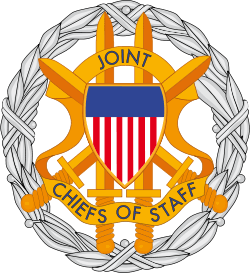
.jpg)

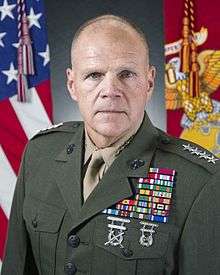
.jpg)

.jpg)

